Text
October so far:
October 1 - Minecraft Steve In smash
October 2 - Trump gets covid
103K notes
·
View notes
Text

HOW TO WAKE UP EARLY
So you have a few 9am classes which means that you have to be up early. And if you’re not a morning person - this means surviving on a WHOLE lot of coffee. Below I’ve compiled a list of my top ten tips on how to wake up early (without feeling like you want to die).
HAVE A GOOD REASON FOR WANTING TO WAKE UP EARLY. Set something to do early in the morning that’s important/fun. This might be something like exercising, checking emails, studying, cooking a nice breakfast, wearing a cute outfit etc. This reason will motivate you to get up.
DON’T GO FROM WAKING UP AT 9AM TO WAKING UP AT 6AM. Just… don’t do this. Start by waking up 30 minutes earlier, and then 45 minutes earlier, and slowly build it up. Do the same with the time you go to sleep - don;t go from sleeping at 1am to sleeping at 10pm. Start with 12am, then 11.30 etc.
PREPARE THE NIGHT BEFORE. Clothes, school bag, water bottle, food. It saves so much time in the morning and if you think about it, you can sleep in a little more if you’re prepared.
PUT YOUR ALARM/PHONE ON THE OTHER SIDE OF YOUR ROOM. This means you have to get up to turn it off and you are MUCH less likely to hit snooze. BUT if you have trouble waking up right away, have a three alarms set. First one 20 minutes before the time you want to wake up, second the time you want to wake up and the last twenty minutes after. The first one will wake you up a little and if you fall asleep for 20 minutes, it won’t be a deep sleep. The last one is to make sure you don’t oversleep. This brings me onto the next point:
STOP SNOOZING. Continuously pressing snooze in the morning to get those extra 8-minute intervals of rest can be really disruptive for your sleep. It is BEST to sleep for a solid block of time (at least one REM cycle) and then be awake for a solid block of time.
NAP DURING THE DAY - it will help you compensate for the low amount of sleep you’ll get in the process of becoming a morning person. But stop taking them as soon as your able to get over 7 hours of sleep per night. NEVER take a nap after 4 PM though, that’s just gonna wreck up your night’s sleep!
SLEEP WITH THE CURTAINS/BLINDS SLIGHTLY OPEN. In the morning, the sunlight will naturally creep in and awaken you more easily!
NO CAFFEINE AND NO ALCOHOL. I mean this both before you go to bed, and when you wake up. Instead, have a drink of cold water to help you wake up, or an apple!! And if you need something warm before you go to sleep, drink decaffeinated tea/coffee/cocoa.
CONSIDER: light/no makeup routine , small/no breakfast, evening showers/skin care, 8 hours of sleep, turning off electronics 1 hour before bed, etc.
TRY SLEEPING APPS. There are tons of apps out there to help your sleep schedule. A few off the top of my head are: Headspace, Calm, WhiteNoise, Pacifica, Sleepyti.me.
260 notes
·
View notes
Text
Hey yo I'm posting commission info again bc I can change out of the ableist professor's drawing class (he insists my disabilities are fake. Even though I've registered with the disability office) but its gonna take me $474 :(( this is just to help get some of the money.
Physical
Watercolor simple -$20
Watercolor complex - $40
Acrylic simple - $30
Acrylic complex - $60
Color pencil realism - $70
Color pencil cartoon - $50
(All physical pieces will have shipping included to the final cost)
Digital
Simple - $20
Complex - $40
Simple gif - $20
Icons - $15
(Both physical and digital add $10 per additional character)
Will draw:
Furries, anime, special interests, frogs
Will try to draw:
Mechs (but no promises)
Will NOT draw:
Nsfw, real human ships, child ships
10 notes
·
View notes
Text
Mushroom-Cryptid Stickers Crowdfunding!
I officially have a crowdfunding open to raise money for the mushroom mothman stickers! The goal is $500! If we reach $1000 I’ll /also/ be ordering iron-on patches of mothman! I’d really appreciate it if even if you can’t afford to donate if you’d at least share! This is all-or-nothing, so I have to have raised the minimum of $500 by August 14th to keep the money and buy the stickers and equipment with it! Donating $8 automatically gets you a mothman sticker, donating $10 gets you a fresno nightcrawler sticker, and donating $30 gets both an Iron-on Patch AND a sticker of your choice!
https://www.indiegogo.com/projects/mushroom-cryptids/x/23906956#/
3 notes
·
View notes
Text
My friend is celebrating Eid without insulin because he had to make the decision between letting his mother go homeless or paying for insulin.
If you would like to help him he needs $300 for insulin, needles, and cleaning supplies.
If you didn’t know: reusing needles can make people sick or die
And going without insulin while diabetic can also kill people, as can be seen when a man tried raising money for insulin and was $50 short so he died
If you are able and willing, you can donate to his paypal here: https://www.paypal.me/14blvd78
Have a good day
5K notes
·
View notes
Text
Foraminifera: Introduction and anatomy
There’s a lot more to palaeontology than just dinosaurs. I’m sure you’re familiar with fossil mammals like mammoths and sabre-tooths. Everyone loves fossil fish like Dunkleosteus and Megalodon. Fossil invertebrates, like trilobites or ammonites, are some of the most famous fossils of all time. And fossil plants are all over the place, from petrified wood to leaf impressions in coal. But have you ever thought about fossil microorganisms?

(Image: Single-celled organisms like this foraminifera are among the most common organisms today, but the vast majority are microscopically small. [Source])
Microbes are everywhere on Earth today, and they have been everywhere on Earth for seemingly as long as life has existed. They live in practically every environment—but their small size and soft bodies have meant that fossils of them are very rare.
Well, almost all of them, that is. One particular group of single-celled organisms is among the best-studied groups in the entire fossil record, having a highly detailed fossil record stretching back for over 540 million years. These are the hard-shelled foraminifera.
I’ve become enamoured with this neat little group of protists lately. But I’ve been really disappointed with a lot that’s been written about them. For despite being some of the most interesting and geologically famous protists, there has been very little written about them that is accessible to anyone who doesn’t already know a lot about them. I’d like to change that.
What are foraminifera?
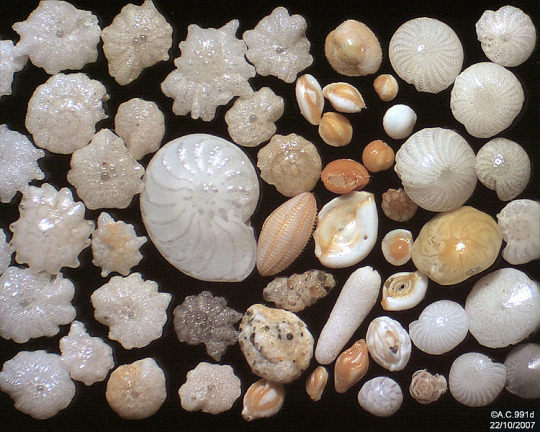
(Image: An assortment of foraminifera shells, with a huge variety of shapes and sizes. More on that later… [Source])
Foraminifera (literally meaning “opening bearers”), or “forams” as they are commonly called, are a group of single-celled eukaryotes. In other words, they have a nucleus (or often multiple of them), and they have mitochondria that act as (say it with me) the powerhouse of the cell. Most forams consume smaller microorganisms as food; however, some are capable of utilising dissolved organic carbon, and many groups have convergently evolved endosymbiotic relationships with photosynthetic algae, including rhodophytes, chlorophytes, and dinoflagellates. In fact, certain foraminifera can extract the chloroplasts from algae they consume and incorporate them into their own cells to do photosynthesis! These don’t last forever, though, and the forams eventually digest the chloroplasts. Some other foraminifera actually actively predate on and kill small animals—an amazing feat for a single-celled organism!
Some of the most famous foraminifera are the planktonic forms that float within the water column; however, the vast majority of forams are benthic organisms. These include forms from shallow water to forms found at the very deepest point of the ocean. Though some benthic species live only above the sediment-water interface and others live only interstitially, most benthic forams are not confined to one mode of life and may move between layers of the community in order to seek out food. Some of these forms can even survive without oxygen for extended periods! This allows them to live in conditions that would kill many other organisms.
A few species of forams have been identified from freshwater environments, and one study presented molecular evidence suggesting foraminifera may be widespread in soils, although no actual forams have been found from soils yet. It seems that there might be a lot of diversity even among living forams that we still have yet to uncover.
Anatomy
Of all single-celled organisms, why is it that foraminifera have such a good fossil record? The answer lies in the hard shell of many species, known as a test.
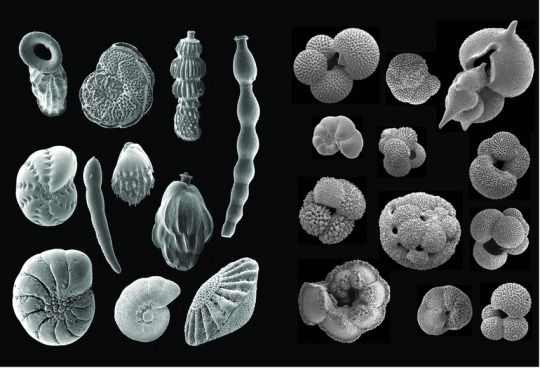
(Image: A variety of test shapes in different foraminifera groups, viewed with a scanning electron microscope. They include may shapes—coiled, glob-shaped, linear, egglike, and more. There are many other shapes of tests that aren’t shown here—like spiralled, branched, disc-like, and more. All of these tests are calcareous. [Source])
These tests are not simply external structures within which foraminifera live; rather, the test is actually within the cell membrane. Although the soft parts of the foraminiferal cell are almost never preserved in the fossil record, modern species of forams have helped us learn a lot about their anatomy. Extending from the opening(s) of the test are pseudopodia, fingerlike extensions of the cell membrane. As the most prominent extensions of the cell outside of the test, they serve a multitude of functions, including locomotion, feeding, agglutinating the test, reproduction, respiration, and excretion. In many forms these pseudopodia extend in all directions through numerous tiny holes in the shell of the test. In other ways the foraminifera anatomically resemble typical single-celled eukaryotes, with nuclei and mitochondria. Some species have multiple nuclei within a single cell). During reproduction, some species of forams can even leave their shell behind entirely to undergo cell division.

(Image: The anatomy of a foraminiferan. Note that the test is actually inside of the cell wall, but most of the cell materials are inside the test. The pseudopodia are the main thing that extend out of the aperture, or hole. This drawing is a unilocular, or single-chambered, foram.)
The most famous and diverse of these are foraminifera with calcareous tests. Calcareous means that they are made of calcium carbonate, and calcium carbonate takes two main forms: Calcite and aragonite. Calcite is a very common mineral in nature; it’s the stuff that makes up limestone, marble, antacids, coral skeletons, and more. And aragonite is a mineral with the same chemical composition as calcite, but with a different crystal structure. It’s found in the shells of many organisms, like snails. Both calcite and aragonite tests are found in foraminifera, and many species have their own particular composition and crystal structure.
Other forams have agglutinated tests: that is, tests that are made by collecting bits of sand and cementing them together, using either organic proteins or calcite to hold them together.

(Image: An agglutinated textulariid foram. Its test is made from sediment grains connected together. It looks a bit like an ice cream cone in shape, but rather than conical, it’s flat. And the top is sealed off. So really, it looks nothing like an ice cream cone. [Source])
Fewer still forams secrete tests of silica—the material that quartz and glass are made of. Others have softer tests made completely from proteins and other organic material. Even rarer are foraminifera which entirely lack tests and were until recently considered to be amoebae; these species likely secondarily lost the test.
Test composition appears to be pretty fluid in foram evolution. In the family tree of foraminifera, it seems that calcite tests evolved multiple times, and so did agglutinated tests. In some cases it looks like they might have even gone from calcite tests to agglutinated tests.
Test shape is also highly diverse within foraminifera. The simplest shape of test are the unilocular, or single-chambered, forms; however, unilocular forms may also have more complex chamber shapes, including spiraled tubes outwardly resembling snail shells. Unilocular forms are found in several groups of forams. The earliest foraminifera were probably all unilocular, and modern unilocular forams probably form a paraphyletic “grade” rather than a true branch of the tree of life. Single-chambered foraminifera probably make up the bulk of forams alive today, but many of these species remained undiscovered and unnamed.
Although unilocular forams are frequently considered the “simplest” forams, they also include some of the most bizarre protists, the xenophyophores. These are my favourite group of foraminifera, and the reason is, I think, pretty clear—they’re enormous. Like, I mean, the largest ones can get up to 20cm/8in across! These are the largest known single-celled organisms on the planet. All of the known species live on the floor of the deep ocean, where they filter-feed.

(Image: A xenophyophore, a giant, single-celled foraminifera. It looks a bit like a sponge, which is what it was once mistaken for. [Source])
Most named species of forams, however, are multilocular, having multiple chambers within their tests. The tests of the most well-known forms superficially resemble the shells of ammonites or nautili. In fact, the earliest scientific descriptions of foraminifera described them as being tiny cephalopods! The septa (internal dividing walls) of foraminiferal tests have holes that allow for the cytoplasm to flow between compartments, so that the cell can make use of all of the available space within the test. These openings—or foramina—also provided the name for the group: When initially thought to be cephalopods, they could be distinguished from all other coiled forms by the foramina between compartments.
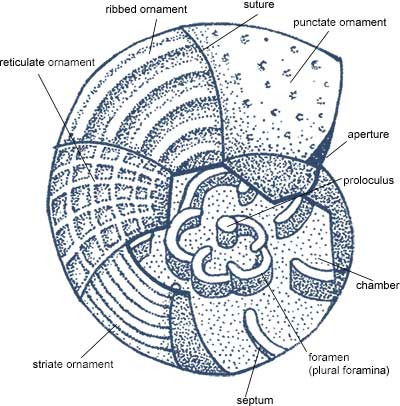
(Image: Cross-sectional diagram of a coiled, multichambered foraminifera. It does look a lot like a nautilus, and even has multiple chambers in its shell. However, unlike nautili, these chambers are connected by holes. [Source])
Not all multilocular foraminifera are coiled, however; many form more linear or globular shapes. Some are even star-shaped! Giants in their own right are found among the multilocular forms: the rotaliid genus Nummulites, though now smaller, has extinct representatives that could reach 15cm across, with up to 4300 distinct compartments. These lens-shaped forams make up the limestone that was used to build the Great Pyramids in Giza.
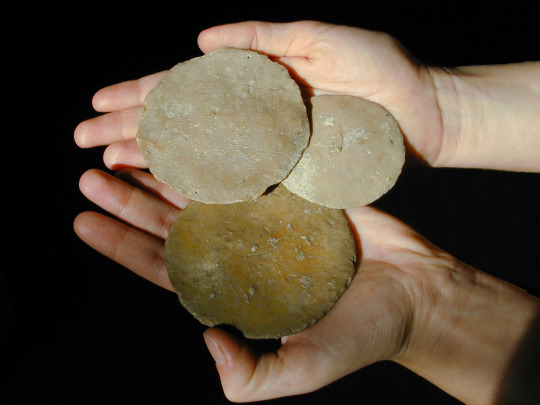
(Image: Fossil Nummulites shells being held by a human. They kind of look like pancakes, and are about 15cm/6in in diametre. Though you can’t see it here, they are actually coiled shells. [Source])
This post is the first in a multi-part series covering foraminifera—their anatomy, reproduction, evolutionary history, major groups, and geological applications. Later parts will be linked here, or check the “Foraminifera” tag on my blog!
271 notes
·
View notes
Text
YES.
Specifically aimed at the advisor I had last year who caused me to nearly drop out of school and who had me leaving in TEARS every meeting I had with her, made even worse considering I had two classes with her a week.
YES, I know I’m disabled. I know and have accepted it might take longer for me to get my bachelor’s degree than everyone else due to being disabled, there’s literally nothing wrong with that. I have no idea why you pick me, the only disabled student, out of a class of literally seven students, to pick on and specifically use as an example of someone who can’t “cope with the program”. I could cope. I dropped out and changed majors because you were so fucking toxic. I was balancing four three-five hour physical therapy sessions a week, nineteen credit hours worth of classes, a double honors major and double minor that YOU enrolled me for, and new drug cocktail after new drug cocktail. And yet you chose to make me feel like shit because I couldn’t take summer classes because I’d probably be in surgery and recovery in the summer due to a physical disability, and in your eyes, me worrying more about my physical health than graduating my bachelor’s in four years was a sign that i was inherently lazy and wrong.
Hey professors grading me down for late work even after I sent you an email letting you know what's going on in my life and that my mental health isn't great in this pandemic...
I will remember your names forever and I will speak them when I give talks in my field WITH examples of how toxic academia and coldness in tech locks talent out of CS.
21 notes
·
View notes
Photo

FAMOUS AUTHORS
Classic Bookshelf: This site has put classic novels online, from Charles Dickens to Charlotte Bronte.
The Online Books Page: The University of Pennsylvania hosts this book search and database.
Project Gutenberg: This famous site has over 27,000 free books online.
Page by Page Books: Find books by Sir Arthur Conan Doyle and H.G. Wells, as well as speeches from George W. Bush on this site.
Classic Book Library: Genres here include historical fiction, history, science fiction, mystery, romance and children’s literature, but they’re all classics.
Classic Reader: Here you can read Shakespeare, young adult fiction and more.
Read Print: From George Orwell to Alexandre Dumas to George Eliot to Charles Darwin, this online library is stocked with the best classics.
Planet eBook: Download free classic literature titles here, from Dostoevsky to D.H. Lawrence to Joseph Conrad.
The Spectator Project: Montclair State University’s project features full-text, online versions of The Spectator and The Tatler.
Bibliomania: This site has more than 2,000 classic texts, plus study guides and reference books.
Online Library of Literature: Find full and unabridged texts of classic literature, including the Bronte sisters, Mark Twain and more.
Bartleby: Bartleby has much more than just the classics, but its collection of anthologies and other important novels made it famous.
Fiction.us: Fiction.us has a huge selection of novels, including works by Lewis Carroll, Willa Cather, Sherwood Anderson, Flaubert, George Eliot, F. Scott Fitzgerald and others.
Free Classic Literature: Find British authors like Shakespeare and Sir Arthur Conan Doyle, plus other authors like Jules Verne, Mark Twain, and more.
TEXTBOOKS
Textbook Revolution: Find biology, business, engineering, mathematics and world history textbooks here.
Wikibooks: From cookbooks to the computing department, find instructional and educational materials here.
KnowThis Free Online Textbooks: Get directed to stats textbooks and more.
Online Medical Textbooks: Find books about plastic surgery, anatomy and more here.
Online Science and Math Textbooks: Access biochemistry, chemistry, aeronautics, medical manuals and other textbooks here.
MIT Open Courseware Supplemental Resources: Find free videos, textbooks and more on the subjects of mechanical engineering, mathematics, chemistry and more.
Flat World Knowledge: This innovative site has created an open college textbooks platform that will launch in January 2009.
Free Business Textbooks: Find free books to go along with accounting, economics and other business classes.
Light and Matter: Here you can access open source physics textbooks.
eMedicine: This project from WebMD is continuously updated and has articles and references on surgery, pediatrics and more.
MATH AND SCIENCE
FullBooks.com: This site has “thousands of full-text free books,” including a large amount of scientific essays and books.
Free online textbooks, lecture notes, tutorials and videos on mathematics: NYU links to several free resources for math students.
Online Mathematics Texts: Here you can find online textbooks likeElementary Linear Algebra and Complex Variables.
Science and Engineering Books for free download: These books range in topics from nanotechnology to compressible flow.
FreeScience.info: Find over 1800 math, engineering and science books here.
Free Tech Books: Computer programmers and computer science enthusiasts can find helpful books here.
CHILDREN’S BOOKS
byGosh: Find free illustrated children’s books and stories here.
Munseys: Munseys has nearly 2,000 children’s titles, plus books about religion, biographies and more.
International Children’s Digital Library: Find award-winning books and search by categories like age group, make believe books, true books or picture books.
Lookybook: Access children’s picture books here.
PHILOSOPHY AND RELIGION
Bored.com: Bored.com has music ebooks, cooking ebooks, and over 150 philosophy titles and over 1,000 religion titles.
Ideology.us: Here you’ll find works by Rene Descartes, Sigmund Freud, Karl Marx, David Hume and others.
Free Books on Yoga, Religion and Philosophy: Recent uploads to this site include Practical Lessons in Yoga and Philosophy of Dreams.
The Sociology of Religion: Read this book by Max Weber, here.
Religion eBooks: Read books about the Bible, Christian books, and more.
PLAYS
ReadBookOnline.net: Here you can read plays by Chekhov, Thomas Hardy, Ben Jonson, Shakespeare, Edgar Allan Poe and others.
Plays: Read Pygmalion, Uncle Vanya or The Playboy of the Western World here.
The Complete Works of William Shakespeare: MIT has made available all of Shakespeare’s comedies, tragedies, and histories.
Plays Online: This site catalogs “all the plays [they] know about that are available in full text versions online for free.”
ProPlay: This site has children’s plays, comedies, dramas and musicals.
MODERN FICTION, FANTASY AND ROMANCE
Public Bookshelf: Find romance novels, mysteries and more.
The Internet Book Database of Fiction: This forum features fantasy and graphic novels, anime, J.K. Rowling and more.
Free Online Novels: Here you can find Christian novels, fantasy and graphic novels, adventure books, horror books and more.
Foxglove: This British site has free novels, satire and short stories.
Baen Free Library: Find books by Scott Gier, Keith Laumer and others.
The Road to Romance: This website has books by Patricia Cornwell and other romance novelists.
Get Free Ebooks: This site’s largest collection includes fiction books.
John T. Cullen: Read short stories from John T. Cullen here.
SF and Fantasy Books Online: Books here include Arabian Nights,Aesop’s Fables and more.
Free Novels Online and Free Online Cyber-Books: This list contains mostly fantasy books.
FOREIGN LANGUAGE
Project Laurens Jz Coster: Find Dutch literature here.
ATHENA Textes Francais: Search by author’s name, French books, or books written by other authors but translated into French.
Liber Liber: Download Italian books here. Browse by author, title, or subject.
Biblioteca romaneasca: Find Romanian books on this site.
Bibliolteca Virtual Miguel de Cervantes: Look up authors to find a catalog of their available works on this Spanish site.
KEIMENA: This page is entirely in Greek, but if you’re looking for modern Greek literature, this is the place to access books online.
Proyecto Cervantes: Texas A&M’s Proyecto Cervantes has cataloged Cervantes’ work online.
Corpus Scriptorum Latinorum: Access many Latin texts here.
Project Runeberg: Find Scandinavian literature online here.
Italian Women Writers: This site provides information about Italian women authors and features full-text titles too.
Biblioteca Valenciana: Register to use this database of Catalan and Valencian books.
Ketab Farsi: Access literature and publications in Farsi from this site.
Afghanistan Digital Library: Powered by NYU, the Afghanistan Digital Library has works published between 1870 and 1930.
CELT: CELT stands for “the Corpus of Electronic Texts” features important historical literature and documents.
Projekt Gutenberg-DE: This easy-to-use database of German language texts lets you search by genres and author.
HISTORY AND CULTURE
LibriVox: LibriVox has a good selection of historical fiction.
The Perseus Project: Tufts’ Perseus Digital Library features titles from Ancient Rome and Greece, published in English and original languages.
Access Genealogy: Find literature about Native American history, the Scotch-Irish immigration in the 19th and 20th centuries, and more.
Free History Books: This collection features U.S. history books, including works by Paul Jennings, Sarah Morgan Dawson, Josiah Quincy and others.
Most Popular History Books: Free titles include Seven Days and Seven Nights by Alexander Szegedy and Autobiography of a Female Slave by Martha G. Browne.
RARE BOOKS
Questia: Questia has 5,000 books available for free, including rare books and classics.
ARTS AND ENTERTAINMENT
Books-On-Line: This large collection includes movie scripts, newer works, cookbooks and more.
Chest of Books: This site has a wide range of free books, including gardening and cooking books, home improvement books, craft and hobby books, art books and more.
Free e-Books: Find titles related to beauty and fashion, games, health, drama and more.
2020ok: Categories here include art, graphic design, performing arts, ethnic and national, careers, business and a lot more.
Free Art Books: Find artist books and art books in PDF format here.
Free Web design books: OnlineComputerBooks.com directs you to free web design books.
Free Music Books: Find sheet music, lyrics and books about music here.
Free Fashion Books: Costume and fashion books are linked to the Google Books page.
MYSTERY
MysteryNet: Read free short mystery stories on this site.
TopMystery.com: Read books by Edgar Allan Poe, Sir Arthur Conan Doyle, GK Chesterton and other mystery writers here.
Mystery Books: Read books by Sue Grafton and others.
POETRY
The Literature Network: This site features forums, a copy of The King James Bible, and over 3,000 short stories and poems.
Poetry: This list includes “The Raven,” “O Captain! My Captain!” and “The Ballad of Bonnie and Clyde.”
Poem Hunter: Find free poems, lyrics and quotations on this site.
Famous Poetry Online: Read limericks, love poetry, and poems by Robert Browning, Emily Dickinson, John Donne, Lord Byron and others.
Google Poetry: Google Books has a large selection of poetry, fromThe Canterbury Tales to Beowulf to Walt Whitman.
QuotesandPoem.com: Read poems by Maya Angelou, William Blake, Sylvia Plath and more.
CompleteClassics.com: Rudyard Kipling, Allen Ginsberg and Alfred Lord Tennyson are all featured here.
PinkPoem.com: On this site, you can download free poetry ebooks.
MISC
Banned Books: Here you can follow links of banned books to their full text online.
World eBook Library: This monstrous collection includes classics, encyclopedias, children’s books and a lot more.
DailyLit: DailyLit has everything from Moby Dick to the recent phenomenon, Skinny Bitch.
A Celebration of Women Writers: The University of Pennsylvania’s page for women writers includes Newbery winners.
Free Online Novels: These novels are fully online and range from romance to religious fiction to historical fiction.
ManyBooks.net: Download mysteries and other books for your iPhone or eBook reader here.
Authorama: Books here are pulled from Google Books and more. You’ll find history books, novels and more.
Prize-winning books online: Use this directory to connect to full-text copies of Newbery winners, Nobel Prize winners and Pulitzer winners.
555K notes
·
View notes
Link
General surgery had significantly more Gryffindors (p = 0.04) and fewer Hufflepuffs (p = 0.0017) whereas orthopedic surgery had significantly more Slytherins (p = 0.0282).
this is in a peer reviewed medical journal i’m screaming
574 notes
·
View notes
Text
i just switched my major to criminal justice and i would love to follow people who have an interest in criminal justice too !! please reblog this post so i and others can follow you too \(^ω^\) 💫✨🌥
33 notes
·
View notes
Text
Hey, shoutout to all of the girls doing the "thrift with me" videos on youtube. Without fail, out of every five videos I watch, there's at least two or three that go "today we scored the big changing room for all of these pants!!" And I've even seen a few brush past a handicapped shopper. Did you... not think that... maybe... the only big stall...... was for a wheelchair user...??? I'm a part-time user for a cane and a chair. Without fail, I've had people push my chair out of the way in the bathroom to reach the handicap stall. At the aquarium I've had people pull my chair out of the wheelchair slot to get access to the tanks. I've had a man try to pull me out of my chair to try to sit in my chair. Does it not occur to anyone that bigger stalls are for people who need the space? That it's not hard to give common fucking courtesy?
Sorry, a bit of a rant, but it's something that keeps bugging me. It's a daily issue.
4 notes
·
View notes
Text
TLDR: Taal Volcano (located in the Philippines) is active right now and could have a massive eruption at any moment. ~560,000 people are in immediate danger and millions more could be affected by it.
(this is barely being reported on by western news btw. why talk about natural disasters when we could talk about british royal family drama)


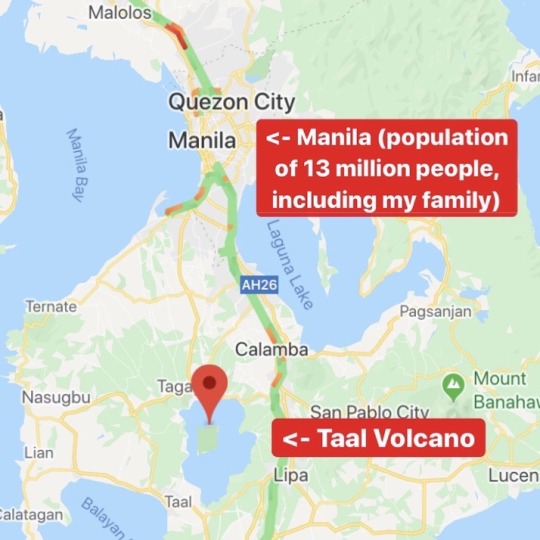

What’s happened as of January 14th, 2020:
“The Philippine Institute of Volcanology and Seismology has since raised the alert for Taal to level 4 which means a ‘hazardous eruption’ is possible within days or hours.”
On January 13th, Taal shot lava into the air for an hour and a half, reaching hights of half a mile, along with static lighting and giant clouds of ash
Taal has had 50 volcanic earthquakes within a period of 8 hours
Buildings close to Taal have collapsed under the weight of ash
The “calamity zone” is everywhere within a 9 mile radius of the volcano. 560,000 people live in this zone and only 30,000 have evacuated.
It’s in the middle of a huge lake (as you can see in the pictures), and an eruption could trigger a tsunami
The CNN Philippines website has a list of groups accepting donations to help evacuees
24K notes
·
View notes
Text
We have to burn kudzu back off of the roads here bi-yearly or it'll take over. Instead, it's learnt to go up across the electrical lines to reach the other side of the road.
Building a treehouse is the biggest insult to a tree. “I killed your friend, here hold him.”
293K notes
·
View notes
Text
When both of my knees are hurting and I’m struggling to figure out which knee needs the brace more

243 notes
·
View notes
Text
My sociology professor had a really good metaphor for privilege today. She didn’t talk about race or gender or orientation or class, she talked about being left-handed.
A left-handed person walks into most classrooms and immediately is made aware of their left-handedness - they have to sit in a left-handed seat, which restricts their choices of where to sit. If there are not enough left-handed seats, they will have to sit in a right-handed seat and be continuously aware of their left-handedness. (There are other examples like left-handed scissors or baseball mitts as well.)
Meanwhile, right-handed people have much more choice about where to sit, and almost never have to think about their right-handedness.
Does this mean right-handed people are bad? No.
Does it mean that we should replace all right-handed desks with left-handed desks? No.
But could we maybe use different desk styles that can accommodate everyone and makes it so nobody has limited options or constant awareness that they are different? Yes.
Now think of this as a metaphor. For social class. For race. For ethnicity. For gender. For orientation. For anything else that sets us apart.
120K notes
·
View notes
Text
Upcoming Semester
This semester I have two days of classes, scheduled that way to allow me to go to school in between on wednesdays for coursework/homework/etc and to have monday/friday off due to copious doctors appointments and four hour long physical therapy sessions. I learned my lesson last semester (whoops, sorry Davidson).
Schedule:
Tuesday/Thursday:
8:15-9:35 History of the U.S. to 1877
9:45-11:05 Intro to Women’s Studies
12:45-2:05 Intro to the Criminal Justice System
Online (no announced time) Critical Thinking/Argumentation and Debate
so overall, 12 credit hours compared to the 17 last semester. Mondays and Fridays are for Appointments. I’ll still be going to school on wednesdays to use the library/better internet and to provide moral support to my boyfriend who has to be there at 8 am on wednesdays.
2 notes
·
View notes
Text
Things to do on Sundays for a more productive week
Do a big brain dump of all the things you need to do —> Do any of the tasks that would take under 15 minutes
Review your calendar for the week
Make a plan to work on any upcoming projects throughout the week
Plan your outfits for the week (check the weather first!)
Check your bank account
Take a look at your budget (or make one if you don’t already have one!)
Get to inbox zero (go through your emails so that you have zero unread emails, reply to any emails you need to and unsubscribe from those spam ones)
Make your to do list for Monday
Clean your dorm/apartment/house
Do laundry
Make a meal plan
Go grocery shopping
Meal prep
Spend some time on self care
Go to bed early
11K notes
·
View notes